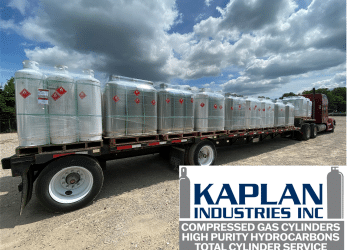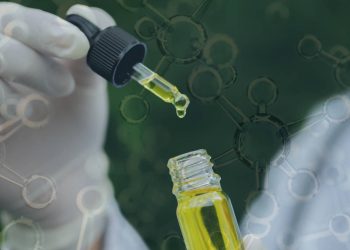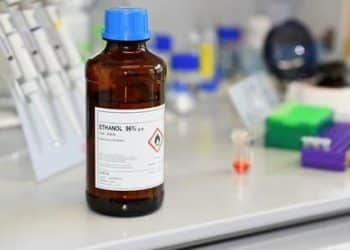Some companies design extraction equipment. Others excel at product design. Both rely on the cultivation of Cannabis sativa to provide the palette necessary to hone one’s respective craft. And then, there are companies that transcend these boundaries by controlling their own fates through ensuring that no part of the production chain, such as the farm, extraction, and formulation, is outsourced. These companies, therefore, must be knowledgeable on all variables in the seed-to-sale equation.
I spoke with Joseph Nunez, President of EcoGen Laboratories, a vertically-integrated seed-to-shelf manufacturer of hemp and cannabis-derived products.
“Prior to CBD becoming popular, I worked at an equipment manufacturing company that built closed loop extractors for the cannabis industry,” Joseph replied. “The machinery we were building at this time was too large of scale for the small connoisseur market which was only focused on medical cannabis.”
“I met a gentleman who had hemp seeds for sale,” he continued. “I knew I wanted them but didn’t know what I’d do with them due to the lack of market for hemp products.”
Fast forward two years. “I had a friend who had 450 acres of land, and I remembered the hemp seeds that I had purchased,” Joseph explained. “As I called the Colorado Department of Agriculture and different hemp farmers in the area, I identified a processing problem within the industry. I realized that the manufacturing machines I had built could be put into service. It was then that EcoGen was born.”
In addition to their extraction technology expertise, because EcoGen also cultivates hemp, they understand the importance of starting with stable genetics and feminized seed. “Stable genetics and feminized seed go hand in hand,” Joseph advised. “If you can get to 100% feminized seed, your crop will have a much better chance of success. If you grow regular male and female seeds, your female plants will get pollinated by the males, and they’ll use their energy to produce seeds instead of cannabinoids and terpenes.”
“Crops that get pollinated can end up being 70 to 75% seed, which contains almost no CBD [cannabidiol], so you’re diminishing your yields tremendously,” Joseph continued. “If you’re growing regular male-female seeds, you’re roughly 50/50 males to females. Half of your land is wasted right out of the gate by growing half males. When grown as feminized plants with no males, you end up producing nothing but pure CBD flowers.”
Once their plants are harvested, EcoGen uses their extraction technology to generate several product lines such as CBD-rich distillate and CBD isolate. Joseph understands the concerns some might have over the isolate production process and the solvents used therein. “The solvents that we use sometimes can be harsh — solvents that you wouldn’t want to consume,” Joseph added. “Our final product does not have residual solvents as we’re able to remove them in the production process.”
“When we send off every batch,” he continued, “our solvent reports come back with zero parts per million. That was one of the most important stages that we had to ensure that we’re not selling a front end that’s laced with harmful chemicals.”
Once the crude oil has been generated, EcoGen filters out waxes and molecules that can turn to free radicals or cause rancidity. Joseph highlighted how filtration presents the only option for removing some of these constituents and the importance of removing plant waxes from products meant to be inhaled. “The waxes can have a similar effect to cutting agents like propylene glycol or vegetable glycerin, which can damage the lining of the lungs,” Joseph cautioned. In another stage, chlorophylls are filtered out as well as residual waxes and tannins that weren’t removed during the first winterization.
Many product manufacturers have begun to look beyond tetrahydrocannabinol (THC) and CBD when assessing which products will be next in their portfolios. In addition to refining crude hemp extract to CBD-rich oils and isolates, EcoGen has also begun exploring the manufacturing of CBG-rich oils and isolates. “There’s commercially available CBG-rich biomass that enables the extraction of larger quantities of CBG-rich oil,” Joseph explained. “The CBG can be crystallized out. With a solvent and a high purity CBG oil, you form the crystals, wash the crystals with a solvent, and then remove the foam.”
“If you have CBD-rich biomass, and the CBG is a minor cannabinoid,” Joseph continued, “you would need a form of chromatography that doesn’t damage the molecules. For example, some forms of chromatography don’t use heat and employ gentle solvents and a gentle silica that doesn’t absorb the other cannabinoids as well.”
Despite the obvious safety concerns that must be addressed, Joseph says part of the success that EcoGen has witnessed results from their use of hydrocarbon solvents. “Our extraction method works well for us is because we’re the only large-scale extraction company that uses hydrocarbons,” Joseph discussed. “Hydrocarbons have low boiling points which makes it easy for us to remove all the solvents first, leaving the terpene profile intact. Many other companies cannot do that because they’re using alcohol extraction and alcohol boils off at roughly the same temperature as some of the terpenes.”
Like us at T&T and EM, Joseph believes that terpenes will continue to be added back into final products. “As soon as people realize the full effect that terpenes have, they will be sought after and people will start focusing on creating different profiles of terpenes,” Joseph acknowledged.
Hemp cultivars, like THC-rich cannabis plants, might differ somewhat in their cannabinoid profiles, but their terpene profiles distinguish them. Knowing what the terpene profile is, and how to best utilize it medicinally, in conjunction with cannabinoids, is really an ultimate endgame of many companies interested in longevity in the cannabis and hemp industries.
“Sometimes cannabis can be stimulating; other plants make someone tired,” Joseph commented. “The biggest effects come from the terpene. The hemp-derived products of tomorrow will keep the amount of CBD, carrier oil, and delivery method the same. The only thing that will differ will be the terpene profiles and these products will be vastly different from each other regarding what they do or how they are used.”
Because of EcoGen’s path to vertical integration, and the requirement of being cognizant of all aspects of the industry, I inquired about Joseph’s advice to specifically the consumers. “The CBD industry isn’t the way it used to be three years ago,” he responded. “I know it may be overwhelming, but people should do as much research as they can. There are currently companies with reputable names that are selling real CBD products and they’re not making snake-oil.”
“Consumers should be wary of products with solvents and products that show that the CBD isn’t even present in the products that they are purchasing,” Joseph continued. “There’s no reason why a CoA [certificate of analysis] shouldn’t be provided with that information on a product label. The biggest thing that’s lacking on product labels is the CBD quantity comprising a dose. Because regulations haven’t been developed yet, people are afraid to label that there’s CBD in the product.”
Navigating the sea of CBD products can be like conquering a maelstrom. Sales and marketing gusts and gales in all directions, threatening to cast everyone overboard. And when CBD products don’t actually contain CBD, as Joseph intimated, it becomes easy to find the eye of the storm, where legitimate companies and products reside. All the while, the chaos encompassing that sanctuary of legitimacy will methodically obliterate itself.












